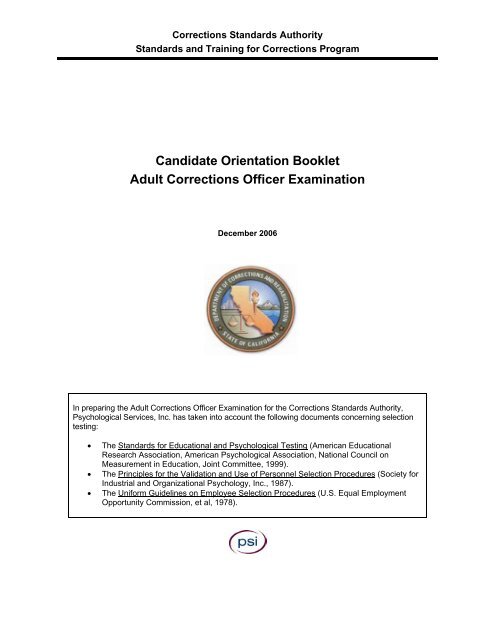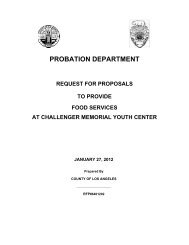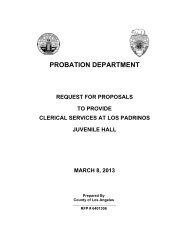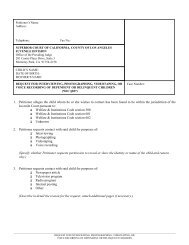Candidate Orientation Booklet Adult Corrections Officer Examination
Candidate Orientation Booklet Adult Corrections Officer Examination
Candidate Orientation Booklet Adult Corrections Officer Examination
You also want an ePaper? Increase the reach of your titles
YUMPU automatically turns print PDFs into web optimized ePapers that Google loves.
<strong>Corrections</strong> Standards Authority<br />
Standards and Training for <strong>Corrections</strong> Program<br />
<strong>Candidate</strong> <strong>Orientation</strong> <strong>Booklet</strong><br />
<strong>Adult</strong> <strong>Corrections</strong> <strong>Officer</strong> <strong>Examination</strong><br />
December 2006<br />
In preparing the <strong>Adult</strong> <strong>Corrections</strong> <strong>Officer</strong> <strong>Examination</strong> for the <strong>Corrections</strong> Standards Authority,<br />
Psychological Services, Inc. has taken into account the following documents concerning selection<br />
testing:<br />
• The Standards for Educational and Psychological Testing (American Educational<br />
Research Association, American Psychological Association, National Council on<br />
Measurement in Education, Joint Committee, 1999).<br />
• The Principles for the Validation and Use of Personnel Selection Procedures (Society for<br />
Industrial and Organizational Psychology, Inc., 1987).<br />
• The Uniform Guidelines on Employee Selection Procedures (U.S. Equal Employment<br />
Opportunity Commission, et al, 1978).
Overview<br />
<strong>Candidate</strong> <strong>Orientation</strong> <strong>Booklet</strong><br />
<strong>Adult</strong> <strong>Corrections</strong> <strong>Officer</strong> <strong>Examination</strong><br />
The <strong>Candidate</strong> <strong>Orientation</strong> <strong>Booklet</strong> is designed to serve four functions:<br />
ACO <strong>Candidate</strong> <strong>Orientation</strong> <strong>Booklet</strong><br />
Page 1<br />
• To provide background information about the development and validation of the<br />
<strong>Adult</strong> <strong>Corrections</strong> <strong>Officer</strong> <strong>Examination</strong>;<br />
• To familiarize candidates with the examination format;<br />
• To preview the contents of the <strong>Adult</strong> <strong>Corrections</strong> <strong>Officer</strong> <strong>Examination</strong>; and<br />
• To provide sample problems (with answers) to help candidates prepare for the<br />
examination.<br />
Description of the <strong>Adult</strong> <strong>Corrections</strong> <strong>Officer</strong> Job<br />
The <strong>Adult</strong> <strong>Corrections</strong> <strong>Officer</strong> ensures a safe, secure and humane environment for those<br />
persons who have been legally incarcerated in local county or city jails. A further role may be to<br />
provide services and/or behavioral controls that would aid in the correction of the inmate’s<br />
behavior and aid them whereby they may be permitted to return to the community. The major<br />
tasks and responsibilities of the ACO are listed below.<br />
<strong>Adult</strong> <strong>Corrections</strong> <strong>Officer</strong> Work Activities<br />
1. Supervising Inmates - Monitoring, directing, and controlling the activity of inmates<br />
during daily interactions, recreational or leisure time activities, work activities, and<br />
activities outside the facility. Enforcing rules and disciplinary actions when<br />
appropriate. Adhering to appropriate security procedures when escorting inmates.<br />
2. Searching and Maintaining Security - Conducting searches, inspections, and<br />
counts (of inmates, visitors, mail, facility, etc.) with thoroughness and accuracy, in<br />
a timely manner. Initiating special searches when appropriate. Verifying<br />
information and identities, securing evidence, and making security checks. Taking<br />
appropriate action in follow-up to searches/inspections/counts. Safeguarding<br />
facility keys and potentially dangerous tools and supplies.<br />
3. Investigating and Detecting Problems - Investigating suspicious activities,<br />
incidents, and situations. Identifying illegal activity and potentially dangerous<br />
conditions (e.g., contraband possession/use, gang conflict, etc.). Taking<br />
appropriate steps to prevent problems before they occur. Recognizing signs of<br />
health problems, suicide risk, assaults, etc., and taking appropriate action to<br />
protect the well being of inmates.
ACO <strong>Candidate</strong> <strong>Orientation</strong> <strong>Booklet</strong><br />
Page 2<br />
4. Report Writing - Writing reports (e.g., incident, disciplinary, escape, crime, arrest),<br />
correspondence, and other narrative reports that are clear, complete, accurate,<br />
and concise; writes reports in a timely manner.<br />
5. Record Keeping - Accurately completing forms, logs, and inventories necessary<br />
for the correct and efficient booking, receiving, and releasing of inmates, operation<br />
of a facility, and daily custody of inmates.<br />
6. Handling Emergencies - Working effectively and taking appropriate actions in<br />
emergency or crisis situations (e.g., injuries, suicide attempts, fires, escapes,<br />
rioting, physical fights between inmates or attacks upon staff). Using sound<br />
judgment and following proper procedures in using physical force or restraints,<br />
sounding and responding to alarms, enlisting and providing appropriate assistance;<br />
and rendering appropriate first aid.<br />
7. Interacting/ Communicating with Inmates - Explaining rules, policies,<br />
expectations, and consequences to inmates. Listening and responding<br />
appropriately to questions, concerns, complaints, and requests and providing<br />
appropriate assistance in working out problems. Respecting inmates' feelings,<br />
rights, and privileges and gaining their cooperation and respect.<br />
8. Interacting/ Communicating with People External to Staff - Conferring with the<br />
public and personnel external to the agency. Establishing cooperative relations<br />
with community, agencies, and other people external to the staff. Dealing with<br />
visitors. Responding to inquiries from regulatory agencies, commissions, and the<br />
courts.<br />
9. Working with Internal Staff - Working cooperatively and effectively with coworkers,<br />
supervisors, and internal staff. Following directions and providing<br />
assistance, coaching, and support when needed. Keeping staff completely<br />
informed regarding inmate status, potential problems, and important shift<br />
information. Keeping current on job knowledge and all facility rules, procedures,<br />
regulations, and other formal written materials relevant to job performance.<br />
10. Performing Physically Demanding Work - Working with physical skill sufficient<br />
to handle emergency situations such as medical emergencies, defending one self,<br />
and pursuing, disarming, subduing and restraining inmates.
Development of the <strong>Adult</strong> <strong>Corrections</strong> <strong>Officer</strong> <strong>Examination</strong><br />
ACO <strong>Candidate</strong> <strong>Orientation</strong> <strong>Booklet</strong><br />
Page 3<br />
The <strong>Adult</strong> <strong>Corrections</strong> <strong>Officer</strong> <strong>Examination</strong> was developed as a result of a three-year statewide<br />
analysis of the corrections officer position. The analysis was undertaken pursuant to state<br />
legislation mandating the development of selection standards for the corrections officer job.<br />
<strong>Examination</strong> development began with a review of job descriptions and related documentation,<br />
site visits, and interviews with corrections officers and their supervisors. The test researchers<br />
developed a job analysis questionnaire from these documents and interviews. The<br />
questionnaire was administered to corrections officers and supervisors from agencies<br />
throughout California. Questionnaire results were used to determine the nature of the<br />
corrections officer job and to develop a clear and complete description of the abilities and<br />
attributes necessary for successful job performance.<br />
A large pool of test items was developed to measure important abilities and attributes identified in<br />
the job analysis as important to job success. These test items were administered to a large<br />
sample of corrections officers working in local detention facilities around the state. Statistical item<br />
analyses were conducted to select test items and cast test forms that exhibited sound<br />
measurement properties. Supervisors of these same officers rated various aspects each officer’s<br />
job performance. The <strong>Adult</strong> <strong>Corrections</strong> <strong>Officer</strong> <strong>Examination</strong> represents a combination of tests<br />
found to predict job performance.<br />
A Word About Terms: Test items are also called test problems and questions. There are two<br />
ways to present test items to test takers: Items can be written as questions (e.g. “How many<br />
dimes are there in a dollar?”) followed by several answer choices; or as statements (e.g.,<br />
“Indicate to what extent you agree with the following statement using the accompanying scale:<br />
“California is a great place to live.”) This information booklet contains references to test items,<br />
questions, and problems.<br />
<strong>Examination</strong> Format<br />
The <strong>Adult</strong> <strong>Corrections</strong> <strong>Officer</strong> <strong>Examination</strong> consists of multiple-choice problems in a single test<br />
booklet and an accompanying answer sheet. You will answer all examination problems on the<br />
answer sheet - DO NOT MARK IN THE TEST BOOKLET ITSELF. Typically, testing will be done<br />
in a group setting. You will have adequate time to complete all test items. Total testing time will be<br />
approximately 2 hours.
Preparing for the <strong>Adult</strong> <strong>Corrections</strong> <strong>Officer</strong> <strong>Examination</strong><br />
ACO <strong>Candidate</strong> <strong>Orientation</strong> <strong>Booklet</strong><br />
Page 4<br />
A brief description of the abilities and attributes measured in each section of the examination is<br />
given on the next page, followed by examples of the types of items you will find in each section.<br />
The <strong>Adult</strong> <strong>Corrections</strong> <strong>Officer</strong> <strong>Examination</strong> contains the following sections:<br />
1. Following Written Directions - Apply a set of rules to determine the correct action<br />
or solution for a problem.<br />
2. Reading Comprehension - Read a passage and answer questions that may require<br />
identifying facts and details, interpreting information, or drawing conclusions.<br />
3. Writing Clarity - Recognize and use clear writing, avoiding writing problems that<br />
result in ambiguous or erroneous communication.<br />
4. Writing Detail - Evaluate written information and determine whether it provides a<br />
useful, detailed description of people or events.<br />
5. Accuracy with Forms and Coded Information - Part A: Check the accuracy of<br />
information coded in report forms compared to a written summary; and Part B:<br />
Compare coded information to a brief list of information and determine whether the<br />
coded information matches any of the items on the list.<br />
6. Work Attitudes - This section of the examination contains various test items<br />
designed to measure attitudes about work-related situations and behavior, reflecting<br />
attributes such as conscientiousness, confidence, handling work pressure, getting<br />
along with others, integrity/trustworthiness, objectivity and tolerance. Please note:<br />
This section of the test should not be confused with a psychological examination that<br />
gauges the extent of your mental health. The <strong>Adult</strong> <strong>Corrections</strong> <strong>Officer</strong> <strong>Examination</strong><br />
is not a measure of your mental well-being and should not be construed as such.<br />
The instructions and sample questions that appear in the examination for each section are<br />
presented on the following pages.
1. Following Written Directions<br />
ACO <strong>Candidate</strong> <strong>Orientation</strong> <strong>Booklet</strong><br />
Page 5<br />
Directions:<br />
In this section, several sets of rules and procedures are presented. Each set is followed by<br />
several short problems that are to be solved by applying the rules. For each problem, mark the<br />
letter (A, B, C, or D) on your answer sheet corresponding to the correct action or solution. An<br />
example is provided below.<br />
Sample Item:<br />
Rules for Assigning Cases to Facilities:<br />
The four facilities are: (A) Main, (B) West, (C) North, and (D) East. Listed below are<br />
the rules for assigning cases to facilities:<br />
• Main facility is for adult males who require maximum security.<br />
• West facility is for adult males who require minimum security.<br />
• North facility is for juveniles (ages 18 and under).<br />
• East facility is for adult females of all security levels.<br />
Problem Main West North East<br />
S1. <strong>Adult</strong> male, minimum security A B C D<br />
S2. 14-year-old youth A B C D<br />
In the first example (S1), option B (West) is marked as the correct<br />
answer. For the second example (S2), you would mark option C.<br />
This section will contain 3 sets of rules and procedures with a total of<br />
22 problems to be solved. Most candidates finish this section of the<br />
test within about 15 minutes.<br />
Sample Answer Sheet<br />
A B C D E<br />
S1. <br />
A B C D E<br />
S2.
2. Reading Comprehension<br />
ACO <strong>Candidate</strong> <strong>Orientation</strong> <strong>Booklet</strong><br />
Page 6<br />
Directions:<br />
In this section, several passages are presented. Each passage is followed by several questions.<br />
Select the best answer to each question based on the information in the passage, marking the<br />
circle (A, B, C, or D) on your answer sheet. An example is provided below.<br />
Sample Item:<br />
First aid is to be given in order of priority. Problems with breathing, circulation, and bleeding are the<br />
highest priority. Injuries to the neck and spine should be identified and treated before injuries to the<br />
extremities. For example, in treating fractures, injuries to the neck and spine are always treated first;<br />
then the head and rib cage; and finally, the arms and legs. Open chest wounds, open abdominal<br />
wounds, shock, and serious burns should all be cared for before fractures are treated.<br />
S1. According to the passage, which of the following injuries should receive the lowest priority for<br />
treatment?<br />
A. An airway blockage.<br />
B. Heavy bleeding from a cut on the arm.<br />
C. Broken ribs.<br />
D. A broken ankle.<br />
Sample Answer Sheet<br />
A B C D E<br />
S1. <br />
For this example, the correct answer is D because, according to the passage, fractures are<br />
lower priority than breathing problems or bleeding, and fractures in the extremities are the<br />
lowest priority.<br />
This section will contain three passages with a total of 17 questions. Most candidates finish this<br />
section of the test within about 15 minutes.
3. Writing Clarity<br />
ACO <strong>Candidate</strong> <strong>Orientation</strong> <strong>Booklet</strong><br />
Page 7<br />
Directions:<br />
Look at the sample item below. A sentence is presented with some of the words underlined.<br />
Four alternative words or phrases are listed to replace the underlined words. Select the word or<br />
phrase from the list that results in the most clearly written sentence. Mark your answer (A, B, C,<br />
or D) on the answer sheet.<br />
Sample Item:<br />
S1. If, in the event that the weapon is found, it should be analyzed.<br />
A. If, in the event that<br />
B. If<br />
C. Now<br />
D. Since if<br />
Sample Answer Sheet<br />
A B C D E<br />
S1. <br />
The correct answer is option B because it provides the most clearly stated sentence, so B is<br />
marked on the sample answer sheet.<br />
This section will contain a total of 13 questions. Most candidates finish this section of the test<br />
within about 10 minutes.
4. Writing Detail<br />
ACO <strong>Candidate</strong> <strong>Orientation</strong> <strong>Booklet</strong><br />
Page 8<br />
Directions:<br />
In this section, pairs of statements are presented which describe the same event or procedure.<br />
For each pair of sentences, determine which one provides the most useful, detailed<br />
information in describing the event or procedure. Mark your answer (A or B) on the answer<br />
sheet. An example is provided below.<br />
Sample Item:<br />
A. A customer at the ATM machine on 12 th and Euclid was robbed at gunpoint today by a masked<br />
man. In addition to being robbed of $250, Julie Montrose, 20, was beaten with a gun. She is in<br />
fair condition.<br />
B. A young woman was robbed at 8:00 this morning at the new ATM station on Euclid Avenue. Her<br />
face was badly bruised and she received a concussion as a result of the beating she received by<br />
the gunman.<br />
The correct answer is option A because it provides more useful and<br />
detailed information about the incident, such as the location, the<br />
people involved, and what happened. You would mark A on your<br />
answer sheet for this problem.<br />
Sample Answer Sheet<br />
A B C D E<br />
S1. <br />
This section will contain a total of 16 questions. Most candidates finish this section of the test<br />
within about 10 minutes.
5. Accuracy with Forms and Coded Information<br />
ACO <strong>Candidate</strong> <strong>Orientation</strong> <strong>Booklet</strong><br />
Page 9<br />
Part A - Directions:<br />
Look at the sample item below. A short paragraph is presented followed by a corresponding<br />
report form. Parts of the report form are numbered that are to be checked for accuracy. For<br />
each numbered part, mark A on your answer sheet if the form is correctly filled in, or mark B if<br />
the form is not correctly filled in.<br />
Sample Item:<br />
On March 14 th a check of the 635 cases for the week showed that all cases were processed on time. Of<br />
these cases, 86 were pre-trial cases. Of the 86 pre-trial cases, 79 were transported to Superior court, and 7<br />
were transported to the medical facility.<br />
For the first sample item (S1), option A is marked because the date<br />
was filled in correctly.<br />
For the second sample item (S2), option B is marked because the<br />
number of cases processed for the week was NOT filled in correctly.<br />
For the third sample item (S3), you would mark B because all cases<br />
were processed on time.<br />
Sample Answer Sheet<br />
A B C D E<br />
S1. <br />
A B C D E<br />
S2. <br />
A B C D E<br />
S3. <br />
You do not have to check every line on the form. Check only those items that have circled<br />
numbers next to them.<br />
This section will contain 2 sets of passages and report forms with a total of 10 items to be<br />
checked. Most candidates finish this section of the test within about 5 minutes.
5. Accuracy with Forms and Coded Information (continued)<br />
ACO <strong>Candidate</strong> <strong>Orientation</strong> <strong>Booklet</strong><br />
Page 10<br />
Part B - Directions:<br />
Look at the sample items below. In the first sample (S1), you will see a code number<br />
presented, 792. Compare that code number to the four code numbers in the same row and see<br />
if any of the numbers match 792. If you see an option in the row that matches, mark the letter<br />
(A, B, C, or D) of that option on your answer sheet. If no match is found, mark E on your<br />
answer sheet.<br />
Sample Items:<br />
Code<br />
Number A B C D E<br />
S1. 792 795 792 790 192 No Match<br />
S2. 6696 6669 9696 6966 6999 No Match<br />
S3. 117! 117! 1171 1!71 !171 No Match<br />
Sample Answer Sheet<br />
A B C D E<br />
S1. <br />
A B C D E<br />
S2. <br />
A B C D E<br />
S3. <br />
The match for S1 is option B, so you would mark B on your answer sheet. There is no match for<br />
S2, so you would mark E on your answer sheet. The match for S3 is option A, so you would mark<br />
A on your answer sheet.<br />
This section will contain 11 codes to be checked for matches. Most candidates finish this<br />
section of the test within about 3 minutes.
6. Work Attitude Survey<br />
ACO <strong>Candidate</strong> <strong>Orientation</strong> <strong>Booklet</strong><br />
Page 11<br />
Directions:<br />
This section contains a variety of multiple-choice test items. Read each statement carefully and<br />
decide the extent to which you agree with the statement. Respond to each item truthfully. Some<br />
of the items may describe things that you have never experienced. In this situation, or if you are<br />
uncertain about a response, choose the one that most closely describes you or your views. Do<br />
not spend too much time on any one item; respond to each item as best as you can and move<br />
on to the next one.<br />
Sample Items:<br />
For each item below, you should mark the letter A to E on the answer sheet corresponding to<br />
your choice of response.<br />
S1. In a crisis situation, you are willing to lead<br />
others.<br />
A. Strongly Disagree<br />
B. Disagree<br />
C. In Between<br />
D. Agree<br />
E. Strongly Agree<br />
S2. You enjoy working with people who are<br />
different from you.<br />
A. Strongly Disagree<br />
B. Disagree<br />
C. In Between<br />
D. Agree<br />
E. Strongly Agree<br />
S3. You work well in situations that require you<br />
to "think on your feet."<br />
A. Strongly Disagree<br />
B. Disagree<br />
C. In Between<br />
D. Agree<br />
E. Strongly Agree<br />
S4. It is hard for you to remain even-tempered<br />
when others are being rude or obnoxious.<br />
A. Strongly Disagree<br />
B. Disagree<br />
C. In Between<br />
D. Agree<br />
E. Strongly Agree<br />
This section will contain 145 questions. Most candidates finish this section of the test within<br />
about 35 minutes.
Your Score<br />
ACO <strong>Candidate</strong> <strong>Orientation</strong> <strong>Booklet</strong><br />
Page 12<br />
The <strong>Adult</strong> <strong>Corrections</strong> <strong>Officer</strong> <strong>Examination</strong> uses a compensatory scoring process. This means<br />
that good performance on one section of the examination may offset relatively poor<br />
performance on another portion of the test. The individual sections of the test are not scored<br />
separately. Because of this, a breakdown of how you perform on each section will not be<br />
available. You do not pass or fail individual sections of the examination. What counts is your<br />
total score -- you pass or fail the entire test only.<br />
A Final Word About Testing<br />
Below are several suggestions about taking the <strong>Adult</strong> <strong>Corrections</strong> <strong>Officer</strong> <strong>Examination</strong>. If you<br />
thoroughly review the information in this booklet and follow the suggestions, you will be at your<br />
best when you take the examination.<br />
In general, you should work quickly, but not so fast as to become careless. The time limit has<br />
been set to allow you plenty of time. If you have a question during testing, raise your hand and<br />
a proctor will assist you.<br />
Always read all possible choices before marking your answer. If you don't know the answer to a<br />
problem it is usually best to skip it and go on to the others. If you finish before time is called,<br />
you can go back to any problems you may have skipped.<br />
If you are not sure of the answer to a problem, eliminate the answers you know are wrong and<br />
then mark the choice that is your best guess. You will not be penalized for guessing. Your<br />
score is simply the number of problems you answer correctly so you should not leave any<br />
problems unanswered even if you are only guessing.<br />
You should get a good night's sleep the night before the examination. Some people find that<br />
eating a snack or light meal an hour or two before testing is good preparation.
















